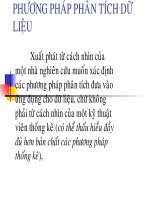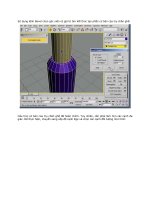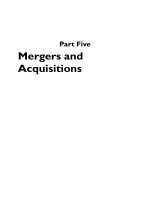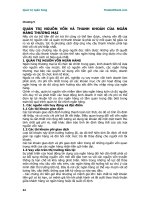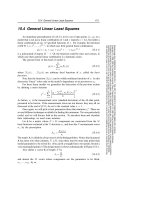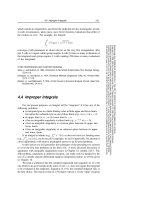Tài liệu Section Three: Reading Comprehension (5) doc
Bạn đang xem bản rút gọn của tài liệu. Xem và tải ngay bản đầy đủ của tài liệu tại đây (87.26 KB, 12 trang )
Section Three: Reading Comprehension (5)
Questions 1-10
William Sydney Porter (1862-1910), who wrote under the pseudonym of O.
Henry, was born in North Carolina. His only formal education was to attend his Aunt
Lina’s school until the age of fifteen, where he developed his lifelong love of books. By
1881 he was a licensed pharmacist. However, within a year, on the recommendation of a
medical colleague of his Father’s, Porter moved to La Salle County in Texas for two
years herding sheep. During this time, Webster’s Unabridged Dictionary was his constant
companion, and Porter gained a knowledge of ranch life that he later incorporated into
many of his short stories. He then moved to Austin for three years, and during this time
the first recorded use of his pseudonym appeared, allegedly derived from his habit of
calling “Oh, Henry” to a family cat. In 1887, Porter married Athol Estes. He worked as a
draftsman, then as a bank teller for the First National Bank.
In 1894 Porter founded his own humor weekly, the “Rolling Stone”, a venture
that failed within a year, and later wrote a column for the Houston Daily Post. In the
meantime, the First National Bank was examined, and the subsequent indictment of 1886
stated that Porter had embezzled funds. Porter then fled to New Orleans, and later to
Honduras, leaving his wife and child in Austin. He returned in 1897 because of his wife’s
continued ill-health, however she died six months later. Then, in 1898 Porter was found
guilty and sentenced to five years imprisonment in Ohio. At the age of thirty five, he
entered prison as a defeated man; he had lost his job, his home, his wife, and finally his
freedom. He emerged from prison three years later, reborn as O. Henry, the pseudonym
he now used to hide his true identity. He wrote at least twelve stories in jail, and after re-
gaining his freedom, went to New York City, where he published more than 300 stories
and gained fame as America’s favorite short Story writer. Porter married again in 1907,
but after months of poor health, he died in New York City at the age of forty-eight in
1910. O. Henry’s stories have been translated all over the world.
1. Why did the author write the passage?
(a) because it is a tragic story of a gifted writer
(b) to outline the career of a famous American
(c) because of his fame as America’s favorite short story writer
(d) to outline the influences on O. Henry’s writing
2. According to the passage, Porter’s Father was
(a) responsible for his move to La Salle County in Texas
(b) the person who gave him a life-long love of books
(c) a medical doctor
(d) a licensed pharmacist
3. The word “allegedly” in line 9 is closest in meaning to
(a) supposedly
(b) reportedly
(c) wrongly
(d) mistakenly
4. Which of the following is true, according to the passage?
(a) both of Porter’s wives died before he died
(b) Porter left school at 15 to become a pharmacist
(c) Porter wrote a column for the Houston Daily Post called “Rolling
Stone”
(d) the first recorded use of his pseudonym was in Austin
5. The word “venture” in line 12 is closest in meaning to
(a) challenging experiment
(b) bold initiative
(c) speculative action
(d) sorry experience
6. The word “subsequent in line 14 is closest in meaning to
(a) resulting
(b) police
(c) alleged
(d) official
7. Porter lost all of the following when he went to prison EXCEPT his
(a) home
(b) wife
(c) job
(d) books
8. According to the author, how many stories did Porter write while in prison for
three years?
(a) more than 300
(b) 35
(c) at least 12
(d) over 20
9. The author implies which of the following is true?
(a) Porter would probably have written less stories if he had not been in
prison for three years
(b) Porter was in poor health throughout his life
(c) O. Henry is as popular in many other countries as he is in America
(d) Porter’s wife might have lived longer if he had not left her in Austin
when he fled.
10. Where in the passage does the author mention a habit of Porter that was to
become very useful for him later?
(a) lines 6-10
(b) lines 11-15
(c) lines 16-20
(d) lines 21-25
Questions 11- 21
Alexis de Tocqueville, the French political scientist, historian, philosopher and
politician, is most famous for a four-volume book he wrote called “Democracy in
America”. He came to America in 1831 to study the American form of democracy and
what it might mean to the rest of the world. After a visit of only nine months, he wrote a
remarkable book which is regarded as a classic. De Tocqueville had unusual powers of
observation. He described not only the democratic system of government and how it
operated, but also its effect on how Americans think, feel, and act. Many scholars believe
he had a deeper understanding of traditional American beliefs and values than anyone
else who has written about the United States. What is so remarkable is that many of these
traits which he observed nearly 200 years ago, are still visible and meaningful today. His
observations are also important because the timing of his visit, the 1830s, was before
America was industrialized. This was the era of the small farmer, the small businessman,
and the settling of the western frontier. It was the period of history when the traditional
values of the new country were newly established. In just a generation, some 40 years
since the adoption of the U.S. Constitution, the new form of government had already
produced a society of people with unique values. He was, however, a neutral observer
and saw both the good and bad sides of these qualities.
The first part of “Democracy in America” was written in 1831-32 and published
in 1835. A highly positive and optimistic account of American government and society,
the book was very well received. He attempted to get a glimpse of the essence of
American society, all the while promoting his own philosophy: the equaling of the classes
and the inevitable depth of aristocratic privilege. The rest of the book he labored on for
four years, and in 1840 the second part was published. This was substantially more
pessimistic than the first, warning of the dangers despotism and governmental
centralization, and applying his ideas and criticisms more directly to France. As a result,
it was not received as well as the first part, except in England where it was acclaimed
highly.
11. What is the passage primarily about?
(a) Alexis de Tocqueville
(b) “Democracy in America”
(c) the progress achieved in America within about 40 years after adoption
of the U.S. Constitution
(d) the impact of the book “Democracy in America”
12. All of the following fields of professional interest and activity are used to
describe de Tocqueville EXCEPT
(a) philosopher
(b) author
(c) political scientist
(d) politician
13. According to the passage, when did de Tocqueville visit America
(a) 1830s
(b) 1831
(c) 1831-32
(d) 1835
14. The phrase “these traits” in lines 9-10 refers to
(a) observations
(b) how Americans think, feel, and act
(c) traditional American beliefs and values
(d) visible and meaningful observations
15. What in the passage is mentioned as being truly remarkable?
(a) many of his observations are still visible and meaningful today
(b) the book was so detailed and thorough after only such a comparatively
short visit
(c) that the second volume should be so pessimistic in comparison with
the first
(d) de Tocqueville’s powers of observation
16. The word “unique” in line 16 is closest in meaning to
(a) clearly identifiable
(b) outstanding
(c) unmatched
(d) positive
17. The word “neutral” in line 16 is closest in meaning to
(a) impartial
(b) careful
(c) important
(d) thorough
18. Which of the following can be inferred from the passage?
(a) the English don’t like the French
(b) the book was most important because it was the first time that
American values had been clearly documented
(c) de Tocqueville was a slow writer
(d) de Tocqueville was primarily motivated by an interest in his own
country
19. The word “glimpse” in line 20 is closest in meaning to
(a) overview
(b) glance
(c) brief understanding
(d) quick conclusion
20. According to the passage, “Democracy in America” consisted of how many
volumes?
(a) one
(b) two
(c) three
(d) four
21. Which of the following is true, according to the passage?
(a) the visit lasted only five months
(b) the visit coincided with American industrialization
(c) the first part was published in 1835; the second part in 1840
(d) the second part was more optimistic than the first
Questions 22-31
The study of the astronomical practices, celestial lore, mythologies, religions and
world-views of all ancient cultures is called archaeoastronomy. It is described, in essence,
as the "anthropology of astronomy", to distinguish it from the "history of astronomy".
Many of the great monuments and ceremonial constructions of early civilizations were
astronomically aligned, and two well-known ancient archaeological sites seem to have
had an astronomical purpose. The Orion mystery, as it is dubbed, purports that the
geometry and brightness of the stars in the Orion constellation are mirrored in the
alignment and size of the great pyramids of Egypt. While this claim remains hypothetical,
it is nevertheless clear that ancient Egyptians incorporated astronomy with architecture.
In the Temple of Abu Simbel, for example, sunlight penetrates a sacred chamber to
illuminate a statue of Ramses on October 18, which ushered in the start of the Egyptian
civil year. Astronomy did not exist on its own, however, but as one limb of a larger body
whose other limbs included agriculture and the after-life. In this sense, astronomy linked
the two themes humans are most obsessed with: life and death.
Around the same period, another monument was erected that combines religion,
architecture and astronomy. Stonehenge was built in three separate stages, starting in
approximately 3000 B.C. Mostly it remains a mystery, but two clues offer some
enlightenment. One is that the megalithic arrangement is not random nor purely aesthetic
but astronomical: It marks the solstice and lunar phases. The other is that archaeological
excavations have revealed it was also used in religious ceremonies. Chinese records
suggest their own astronomical observations dated from the same period; Indian sacred
books point to earlier observations; and Babylonian clay tablets show Chaldean priests
had been observing the sky (including the motion of the visible planets and of eclipses)
shortly thereafter. But the earliest physical vestige of an observatory in fact, lies in
southern Egypt. Surprisingly it is probably not the product of a Semitic (Syrian or
Babylonian) peoples but rather sub-Saharan, as evidenced by analysis of a human
jawbone found on site. The Nabta site is the African equivalent of Stonehenge except it
predates it by some 1,500 years.
22. What does the passage mainly discuss?
(a) the definition and some examples of archaeoastronomy
(b) the possible astronomical significance of ancient monuments
(c) the history of astronomy
(d) the oldest known site possibly used for astronomy
23. The word “celestial” in line 1 could best be replaced by
(a) ancient
(b) historical
(c) heavenly
(d) scientific
24. According to the passage, archaeoastronomy
(a) pre-dates astronomy
(b) is the anthropology of astronomy
(c) is also called the history of astronomy
(d) is not a true science
25. Which of the following, according to the passage, is true about the great
pyramids of Egypt?
(a) they were built for purposes of astronomy
(b) they mark the solstice and lunar phases
(c) one of them contains a statue of Ramses in a sacred chamber
(d) they are part of the Orion mystery
26. The word “ushered” in line 11 is closest in meaning to
(a) brought
(b) identified
(c) marked
(d) signaled
27. The word “illuminate” in line 11 is closest in meaning to
(a) light up
(b) warm up
(c) touch
(d) explain
28. Where in the passage does the author make reference to the moon?
(a) lines 5-9
(b) lines 10-14
(c) lines 15-19
(d) lines 20-24
29. The word “enlightenment” in line 18 is closest in meaning to
(a) awareness
(b) hope
(c) evidence
(d) explanation
30. According to the passage, the earliest known site of an observatory is
probably
(a) Semitic
(b) Babylonian
(c) Chaldean
(d) Sub-Saharan
31. In line 27, the word “it” refers to which of the following?
(a) Stonehenge
(b) the Nabta site
(c) African
(d) sub-Saharan
Questions 32 -39
In 1803 the United States negotiated the purchase of the Louisiana Territory from
France for $15 million. With a stroke of a pen America doubled in size, making it one of
the largest nations in the world. The sale included over 600 million acres at a cost of less
than 3 cents an acre in what today is the better part of 13 states between the Mississippi
River and the Rocky Mountains. For President Thomas Jefferson it was a diplomatic and
political triumph. In one fell swoop the purchase of Louisiana ended the threat of war
with France and opened up the land west of the Mississippi to settlement. By any
measure the purchase of Louisiana was the most important action of Jefferson’s two
terms as president. Jefferson knew that acquiring the very heart of the American
continent would prove to be the key to the future of the United States.
Initially Jefferson sent his minister to France, Robert Livingston, offered
Napoleon $2 million for a small tract of land on the lower Mississippi. There, Americans
could build their own seaport. Impatient at the lack of news, Jefferson sent James Monroe
to Paris to offer $10 million for New Orleans and West Florida. Almost at the same time,
and unknown to Jefferson, France had offered all of Louisiana to Livingston for $15
million.
Though the transaction was quickly sealed, there were those who objected to the
purchase on the grounds that the Constitution did not provide for purchasing territory.
However, Jefferson temporarily set aside his idealism to tell his supporters in Congress
that "what is practicable must often control what is pure theory." The majority agreed.
Jefferson later admitted that he had stretched his power "till it cracked" in order to buy
Louisiana, the largest single land purchase in American history.
32. What is the passage mainly about?
(a) Jefferson’s most important action during two terms as
President
(b) how America doubled in size overnight, through its largest
single land purchase
(c) testing the United States Constitution
(d) Jefferson and his most important action of the Purchase of
Louisiana
33. According to the passage, how much was paid for each acre of land
(a) less than 3 cents
(b) 8 cents
(c) 15 million dollars
(d) over 600 million dollars
34. The word “it” in line 6 refers to
(a) ending the threat of war with France
(b) opening up land west of the Mississippi
(c) the sale
(d) doubling the size of America overnight
35. The word “acquiring” in line 10 is closest in meaning to
(a) going to
(b) obtaining
(c) abandoning
(d) including
36. Which of the following, according to the passage, is NOT true
(a) Jefferson acted outside his constitutional powers
(b) Congress did not fully support Jefferson
(c) Jefferson sent Robert Livingston to France with an offer for
New Orleans and West Florida
(d) America wanted to build its own seaport
37. The word “idealism” in line 20 is closest in meaning to
(a) vision
(b) principles
(c) realism
(d) philosophy
38. The phrase “pure theory” in line 22 is closest in meaning to
(a) meant to be
(b) rules that are meant to be broken
(c) untested rules
(d) the unworkable
39. According to the passage, the word “power” in line 23 refers to
Jefferson using
(a) the negotiations
(b) constitutional power
(c) his idealism
(d) practical power
Questions 40-50
Exquisite patterns and surface ornamentation were an integral part of the
aesthetics of the late Victorian era. In America, these developments were incorporated
into the themes of national expositions and artistic movements, as cottage industries grew
and productivity in the decorative arts flourished. The last three decades of the 19th
century saw a change in sensibility that resulted in new stylistic approaches in American
decorative arts, a departure from the previous era of Rococo and Renaissance Revival
excess. Shapes became more angular, smoother and less flamboyant. The popular
carvings and deep modeling of earlier years disappeared as ornamentation became more
linear and lighter in appearance. Decoration focused on the surface with rich and elegant
patterns adorning furniture, objects of every sort, and architectural and interior
decorations. This artistic reawakening was prompted by the effects of the Industrial
Revolution on contemporary design.
This new attitude, with its focus on ornament and the decorative, was later
referred to as the Aesthetic Movement, but it also encompassed the early Arts and Crafts
Movement as well. The purpose was to bring a refined sensibility and components of
“good taste” to the domestic interior. Art and good taste not only denoted good character,
but also could be used to induce proper moral conduct and actions, thereby contributing
to the betterment of society. This placed a heavy burden on designers/decorators as well
as on women as keepers of the home. Americans drew inspiration from the writing and
work of English artists. This was a period of great eclecticism. Tastes ranged from the
Modern Gothic through the Persian, Greek and Islamic, to the Japanese, and with more
than a nod to Mother Nature. Yet, regardless of the influence, surface pattern reigned
supreme. English reformers dictated that ornament should be derived from nature, and
pattern should be flat and stylized. Forms were accentuated by colored outlines, or often
with touches of gold. The emphasis was on art and on development of a refined
sensibility. It was all a matter of taste.
40. What is the main topic of the passage?
(a) defining the “Aesthetic Movement”
(b) decorative arts in late 19
th
century America
(c) English influences on American decorative arts in the late 19
th
century
(d) The change in tastes from “Rocco and Renaissance Revival” to the
‘Aesthetic Movement” in late 19
th
century America
41. The word “integral” in line 1 is closest in meaning to
(a) essential
(b) additional
(c) important
(d) beautifying
42. According to the passage, during the Aesthetic Movement popular carvings
and deep modeling of earlier years
(a) were popular
(b) again became popular
(c) disappeared
(d) defined good taste
43. The word “elegant” in line 9 is closest in meaning to
(a) beautiful
(b) ornamental
(c) colorful
(d) refined
44. According to the passage, the purpose of the Aesthetic Movement was to
(a) induce proper moral conduct and actions
(b) define what was meant by good taste in the domestic interior
(c) encompass Arts and Crafts as well as ornament an decoration
(d) define good character and contribute to the betterment of society
45. The phrase “new attitude” in line 14 refers to
(a) including the early Arts and Craft Movement as well
(b) artistic reawakening
(c) the Industrial Revolution
(d) Rococo and Renaissance Revival
46. The word “denoted” in line 16 is closest in meaning to
(a) promoted
(b) facilitated
(c) developed
(d) signified
47. Where in the passage does the author mention the influence of art and good
taste on morals?
(a) lines 5-9
(b) lines 10-14
(c) lines 15-20
(d) lines 20-24
48. Which of the following can be inferred from the passage?
(a) designers and decorators were mainly responsible for starting the new
attitude
(b) the movement led to a higher standard of morality in late 19
th
century
America
(c) the Americans considered the English to be the arbiters of good taste
(d) women, as keepers of the home, faced a heavy burden
49. According to the passage, which of the following remained most important,
regardless of influences from other countries?
(a) surface pattern
(b) English opinions
(c) good taste
(d) Proper moral conduct and actions
50. Which of the following is NOT mentioned as a feature of the Aesthetic
Movement?
(a) shapes became less flamboyant
(b) ornamentation became lighter in appearance
(c) forms were accentuated by colored lines
(d) decorations focused mainly on furniture
Test 5 – Answer Key
1.b 2.c 3.a 4.d 5.c 6.a 7.d 8.c 9.c 10.a
11.b 12.b 13.b 14.c 15.a 16.c 17.a 18.b 19.b 20.d
21.c 22.b 23.c 24.b 25.c 26.a 27.a 28.c 29.a 30.d
31.b 32.d 33.a 34.c 35.b 36.c 37.b 38.c 39.b 40.b
41.a 42.c 43.a 44.b 45.b 46.d 47.c 48.d 49.a 50.d
